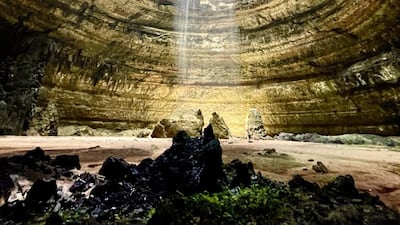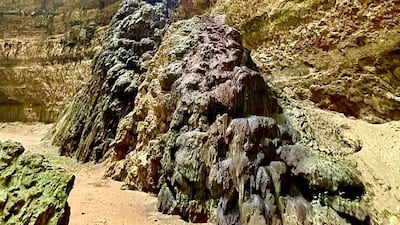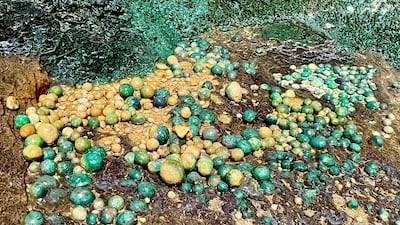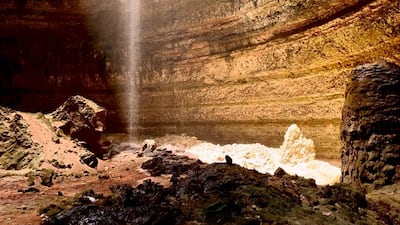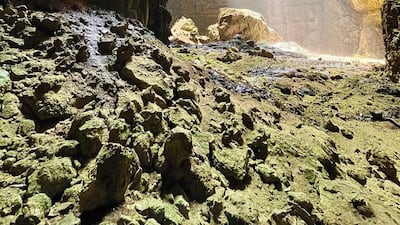With nerves of steel, Mohammad Al Kindi descended through a 30-metre hole in the desert into the foreboding underground cave near Yemen's border with Oman.
Mohammad and a team of Omani cavers recently found out what exactly lay at the bottom of this geological structure known locally as the Well of Barhout or the Well of Hell in Al Mahra region, a mysterious place that has long been the subject of much mythology and folklore.
“Some say it is where apostates and non-believers are tortured after death," the geologist and owner of the Earth Sciences Consultancy Centre tells The National. "Others believe that their heads would be severed once they’re down there.
I was the last one to climb in and the last one to leave. I spent about six hours down there
Mohammad Al Kindi,
cave explorer and geologist
What they found may have been spellbinding, but he says neither he nor his seven teammates felt the effects of any curse.
“They say that Makkah’s Zamzam water is the holiest and purest on earth and that the water from the Well of Hell is the most evil,” he says. “All we saw was pure freshwater down there. We even drank an entire bottle and nothing happened to us!"
Mohammad says he’s always had a passion for natural formations and cave exploration.
“I live in a mountainous area. I have been visiting caves since I was a child,” he says.
But his quest into the belly of the mythical chasm was unlike any other of his adventures. “I was the last one to climb in and the last one to leave. I spent about six hours down there,” he says.
Using surveying equipment and gas detectors, Mohammad and the team found the sinkhole was indeed possessed – by normal levels of oxygen and poison-free air – and he says there was a high number of snakes.
"They procreate when there are no predators to eat them,” he explains. “That's normal."
The most magical elements he saw were the cave pearls that shone through underground waterfalls.
“Cave pearls are concentric calcium carbonate deposits that form around nuclei under falling water. These rings are smoothed by the movement of water falling for thousands of years until they form beautiful pearl shapes,” he said.
With the sinkhole steeped in local folklore, many brave Yemenis and some scientific expeditions claim to have entered and returned, but Mohammad says he saw no indications of any human encroachment at the bottom.
“There were no footprints or other signs of disturbances,” he says. “None of the prior missions there have been documented so it’s unclear whether anyone had actually gone down there, although it’s difficult to be 100 per cent certain.”
Mohammad hopes that with his visit to the bottom of the Well of Hell, his findings can dispel some of the myths surrounding the cave and other similar sites.
"I believe that the Well of Hell, known as Barhout, is a legendary cave assigned to many caves in Yemen. Now that we have gone to Khasfat Foujit, the cave should not be called by any other name than the area it is in."
To make sure there is no demonic phenomenon at other similar sites, Mohammad now plans to visit the Hadramout region in Yemen to investigate whether a similar sinkhole could hold the secrets of the underworld.
“I have no doubt that the one in Hadramout will also be normal, and even small. But with the right conditions, we will go and find out," he says.
Quick pearls of wisdom
Focus on gratitude: And do so deeply, he says. “Think of one to three things a day that you’re grateful for. It needs to be specific, too, don’t just say ‘air.’ Really think about it. If you’re grateful for, say, what your parents have done for you, that will motivate you to do more for the world.”
Know how to fight: Shetty married his wife, Radhi, three years ago (he met her in a meditation class before he went off and became a monk). He says they’ve had to learn to respect each other’s “fighting styles” – he’s a talk it-out-immediately person, while she needs space to think. “When you’re having an argument, remember, it’s not you against each other. It’s both of you against the problem. When you win, they lose. If you’re on a team you have to win together.”
David Haye record
Total fights: 32
Wins: 28
Wins by KO: 26
Losses: 4
Other IPL batting records
Most sixes: 292 – Chris Gayle
Most fours: 491 – Gautam Gambhir
Highest individual score: 175 not out – Chris Gayle (for Royal Challengers Bangalore against Pune Warriors in 2013)
Highest strike-rate: 177.29 – Andre Russell
Highest strike-rate in an innings: 422.22 – Chris Morris (for Delhi Daredevils against Rising Pune Supergiant in 2017)
Highest average: 52.16 – Vijay Shankar
Most centuries: 6 – Chris Gayle
Most fifties: 36 – Gautam Gambhir
Fastest hundred (balls faced): 30 – Chris Gayle (for Royal Challengers Bangalore against Pune Warriors in 2013)
Fastest fifty (balls faced): 14 – Lokesh Rahul (for Kings XI Punjab against Delhi Daredevils in 2018)
Company%C2%A0profile
%3Cp%3ECompany%3A%20Zywa%3Cbr%3EStarted%3A%202021%3Cbr%3EFounders%3A%20Nuha%20Hashem%20and%20Alok%20Kumar%3Cbr%3EBased%3A%20UAE%3Cbr%3EIndustry%3A%20FinTech%3Cbr%3EFunding%20size%3A%20%243m%3Cbr%3ECompany%20valuation%3A%20%2430m%3C%2Fp%3E%0A
It's up to you to go green
Nils El Accad, chief executive and owner of Organic Foods and Café, says going green is about “lifestyle and attitude” rather than a “money change”; people need to plan ahead to fill water bottles in advance and take their own bags to the supermarket, he says.
“People always want someone else to do the work; it doesn’t work like that,” he adds. “The first step: you have to consciously make that decision and change.”
When he gets a takeaway, says Mr El Accad, he takes his own glass jars instead of accepting disposable aluminium containers, paper napkins and plastic tubs, cutlery and bags from restaurants.
He also plants his own crops and herbs at home and at the Sheikh Zayed store, from basil and rosemary to beans, squashes and papayas. “If you’re going to water anything, better it be tomatoes and cucumbers, something edible, than grass,” he says.
“All this throwaway plastic - cups, bottles, forks - has to go first,” says Mr El Accad, who has banned all disposable straws, whether plastic or even paper, from the café chain.
One of the latest changes he has implemented at his stores is to offer refills of liquid laundry detergent, to save plastic. The two brands Organic Foods stocks, Organic Larder and Sonnett, are both “triple-certified - you could eat the product”.
The Organic Larder detergent will soon be delivered in 200-litre metal oil drums before being decanted into 20-litre containers in-store.
Customers can refill their bottles at least 30 times before they start to degrade, he says. Organic Larder costs Dh35.75 for one litre and Dh62 for 2.75 litres and refills will cost 15 to 20 per cent less, Mr El Accad says.
But while there are savings to be had, going green tends to come with upfront costs and extra work and planning. Are we ready to refill bottles rather than throw them away? “You have to change,” says Mr El Accad. “I can only make it available.”
What vitamins do we know are beneficial for living in the UAE
Vitamin D: Highly relevant in the UAE due to limited sun exposure; supports bone health, immunity and mood.
Vitamin B12: Important for nerve health and energy production, especially for vegetarians, vegans and individuals with absorption issues.
Iron: Useful only when deficiency or anaemia is confirmed; helps reduce fatigue and support immunity.
Omega-3 (EPA/DHA): Supports heart health and reduces inflammation, especially for those who consume little fish.
if you go
The flights
Air France offer flights from Dubai and Abu Dhabi to Cayenne, connecting in Paris from Dh7,300.
The tour
Cox & Kings (coxandkings.com) has a 14-night Hidden Guianas tour of Guyana, Suriname and French Guiana. It includes accommodation, domestic flights, transfers, a local tour manager and guided sightseeing. Contact for price.
UAE Premiership
Results
Dubai Exiles 24-28 Jebel Ali Dragons
Abu Dhabi Harlequins 43-27 Dubai Hurricanes
Final
Abu Dhabi Harlequins v Jebel Ali Dragons, Friday, March 29, 5pm at The Sevens, Dubai
Mercedes-AMG GT 63 S E Performance: the specs
Engine: 4.0-litre twin-turbo V8 plus rear-mounted electric motor
Power: 843hp at N/A rpm
Torque: 1470Nm N/A rpm
Transmission: 9-speed auto
Fuel consumption: 8.6L/100km
On sale: October to December
Price: From Dh875,000 (estimate)
Starring: Jamie Foxx, Angela Bassett, Tina Fey
Directed by: Pete Doctor
Rating: 4 stars
2019 Asian Cup final
Japan v Qatar
Friday, 6pm
Zayed Sports City Stadium, Abu Dhabi
RESULTS - ELITE MEN
1. Henri Schoeman (RSA) 57:03
2. Mario Mola (ESP) 57:09
3. Vincent Luis (FRA) 57:25
4. Leo Bergere (FRA)57:34
5. Jacob Birtwhistle (AUS) 57:40
6. Joao Silva (POR) 57:45
7. Jonathan Brownlee (GBR) 57:56
8. Adrien Briffod (SUI) 57:57
9. Gustav Iden (NOR) 57:58
10. Richard Murray (RSA) 57:59
Small Victories: The True Story of Faith No More by Adrian Harte
Jawbone Press
Racecard
6.35pm: American Business Council – Maiden (PA) Dh80,000 (Dirt) 1,600m
7.10pm: British Business Group – Maiden (TB) Dh82,500 (D) 1,200m
7.45pm: CCI France UAE – Handicap (TB) Dh87,500 (D) 1,400m
8.20pm: Czech Business Council – Rated Conditions (TB) Dh105,000 (D) 1,400m
8.55pm: Netherlands Business Council – Rated Conditions (TB) Dh95,000 (D) 1,600m
9.30pm: Indian Business and Professional Council – Handicap (TB) Dh95,000 (D) 1,200m
A little about CVRL
Founded in 1985 by Sheikh Mohammed bin Rashid, Vice President and Ruler of Dubai, the Central Veterinary Research Laboratory (CVRL) is a government diagnostic centre that provides testing and research facilities to the UAE and neighbouring countries.
One of its main goals is to provide permanent treatment solutions for veterinary related diseases.
The taxidermy centre was established 12 years ago and is headed by Dr Ulrich Wernery.
White hydrogen: Naturally occurring hydrogen
Chromite: Hard, metallic mineral containing iron oxide and chromium oxide
Ultramafic rocks: Dark-coloured rocks rich in magnesium or iron with very low silica content
Ophiolite: A section of the earth’s crust, which is oceanic in nature that has since been uplifted and exposed on land
Olivine: A commonly occurring magnesium iron silicate mineral that derives its name for its olive-green yellow-green colour
MATCH INFO
Day 2 at Mount Maunganui
England 353
Stokes 91, Denly 74, Southee 4-88
New Zealand 144-4
Williamson 51, S Curran 2-28
Brief scoreline:
Manchester United 2
Rashford 28', Martial 72'
Watford 1
Doucoure 90'
All the Money in the World
Director: Ridley Scott
Starring: Charlie Plummer, Mark Wahlberg, Michelle Williams, Christopher Plummer
Four stars
Mohammed bin Zayed Majlis
The%20Afghan%20connection
%3Cp%3EThe%20influx%20of%20talented%20young%20Afghan%20players%20to%20UAE%20cricket%20could%20have%20a%20big%20impact%20on%20the%20fortunes%20of%20both%20countries.%20Here%20are%20three%20Emirates-based%20players%20to%20watch%20out%20for.%0D%3Cbr%3E%20%0D%3Cbr%3E%3Cstrong%3EHassan%20Khan%20Eisakhil%3C%2Fstrong%3E%0D%3Cbr%3EMohammed%20Nabi%20is%20still%20proving%20his%20worth%20at%20the%20top%20level%20but%20there%20is%20another%20reason%20he%20is%20raging%20against%20the%20idea%20of%20retirement.%20If%20the%20allrounder%20hangs%20on%20a%20little%20bit%20longer%2C%20he%20might%20be%20able%20to%20play%20in%20the%20same%20team%20as%20his%20son%2C%20Hassan%20Khan.%20The%20family%20live%20in%20Ajman%20and%20train%20in%20Sharjah.%0D%3Cbr%3E%20%0D%3Cbr%3E%3Cstrong%3EMasood%20Gurbaz%3C%2Fstrong%3E%0D%3Cbr%3EThe%20opening%20batter%2C%20who%20trains%20at%20Sharjah%20Cricket%20Academy%2C%20is%20another%20player%20who%20is%20a%20part%20of%20a%20famous%20family.%20His%20brother%2C%20Rahmanullah%2C%20was%20an%20IPL%20winner%20with%20Kolkata%20Knight%20Riders%2C%20and%20opens%20the%20batting%20with%20distinction%20for%20Afghanistan.%0D%3Cbr%3E%20%0D%3Cbr%3E%3Cstrong%3EOmid%20Rahman%3C%2Fstrong%3E%0D%3Cbr%3EThe%20fast%20bowler%20became%20a%20pioneer%20earlier%20this%20year%20when%20he%20became%20the%20first%20Afghan%20to%20represent%20the%20UAE.%20He%20showed%20great%20promise%20in%20doing%20so%2C%20too%2C%20playing%20a%20key%20role%20in%20the%20senior%20team%E2%80%99s%20qualification%20for%20the%20Asia%20Cup%20in%20Muscat%20recently.%0D%3Cbr%3E%3C%2Fp%3E%0A
Company%20Profile
%3Cp%3E%3Cstrong%3ECompany%20name%3A%3C%2Fstrong%3E%20Hoopla%3Cbr%3E%3Cstrong%3EDate%20started%3A%20%3C%2Fstrong%3EMarch%202023%3Cbr%3E%3Cstrong%3EFounder%3A%3C%2Fstrong%3E%20Jacqueline%20Perrottet%3Cbr%3E%3Cstrong%3EBased%3A%3C%2Fstrong%3E%20Dubai%3Cbr%3E%3Cstrong%3ENumber%20of%20staff%3A%3C%2Fstrong%3E%2010%3Cbr%3E%3Cstrong%3EInvestment%20stage%3A%20%3C%2Fstrong%3EPre-seed%3Cbr%3E%3Cstrong%3EInvestment%20required%3A%3C%2Fstrong%3E%20%24500%2C000%3C%2Fp%3E%0A
Pox that threatens the Middle East's native species
Camelpox
Caused by a virus related to the one that causes human smallpox, camelpox typically causes fever, swelling of lymph nodes and skin lesions in camels aged over three, but the animal usually recovers after a month or so. Younger animals may develop a more acute form that causes internal lesions and diarrhoea, and is often fatal, especially when secondary infections result. It is found across the Middle East as well as in parts of Asia, Africa, Russia and India.
Falconpox
Falconpox can cause a variety of types of lesions, which can affect, for example, the eyelids, feet and the areas above and below the beak. It is a problem among captive falcons and is one of many types of avian pox or avipox diseases that together affect dozens of bird species across the world. Among the other forms are pigeonpox, turkeypox, starlingpox and canarypox. Avipox viruses are spread by mosquitoes and direct bird-to-bird contact.
Houbarapox
Houbarapox is, like falconpox, one of the many forms of avipox diseases. It exists in various forms, with a type that causes skin lesions being least likely to result in death. Other forms cause more severe lesions, including internal lesions, and are more likely to kill the bird, often because secondary infections develop. This summer the CVRL reported an outbreak of pox in houbaras after rains in spring led to an increase in mosquito numbers.
if you go
The flights
Direct flights from the UAE to the Nepalese capital, Kathmandu, are available with Air Arabia, (www.airarabia.com) Fly Dubai (www.flydubai.com) or Etihad (www.etihad.com) from Dh1,200 return including taxes. The trek described here started from Jomson, but there are many other start and end point variations depending on how you tailor your trek. To get to Jomson from Kathmandu you must first fly to the lake-side resort town of Pokhara with either Buddha Air (www.buddhaair.com) or Yeti Airlines (www.yetiairlines.com). Both charge around US$240 (Dh880) return. From Pokhara there are early morning flights to Jomson with Yeti Airlines or Simrik Airlines (www.simrikairlines.com) for around US$220 (Dh800) return.
The trek
Restricted area permits (US$500 per person) are required for trekking in the Upper Mustang area. The challenging Meso Kanto pass between Tilcho Lake and Jomson should not be attempted by those without a lot of mountain experience and a good support team. An excellent trekking company with good knowledge of Upper Mustang, the Annaurpuna Circuit and Tilcho Lake area and who can help organise a version of the trek described here is the Nepal-UK run Snow Cat Travel (www.snowcattravel.com). Prices vary widely depending on accommodation types and the level of assistance required.
Gran Gala del Calcio 2019 winners
Best Player: Cristiano Ronaldo (Juventus)
Best Coach: Gian Piero Gasperini (Atalanta)
Best Referee: Gianluca Rocchi
Best Goal: Fabio Quagliarella (Sampdoria vs Napoli)
Best Team: Atalanta
Best XI: Samir Handanovic (Inter); Aleksandar Kolarov (Roma), Giorgio Chiellini (Juventus), Kalidou Koulibaly (Napoli), Joao Cancelo (Juventus*); Miralem Pjanic (Juventus), Josip Ilicic (Atalanta), Nicolo Barella (Cagliari*); Fabio Quagliarella (Sampdoria), Cristiano Ronaldo (Juventus), Duvan Zapata (Atalanta)
Serie B Best Young Player: Sandro Tonali (Brescia)
Best Women’s Goal: Thaisa (Milan vs Juventus)
Best Women’s Player: Manuela Giugliano (Milan)
Best Women’s XI: Laura Giuliani (Milan); Alia Guagni (Fiorentina), Sara Gama (Juventus), Cecilia Salvai (Juventus), Elisa Bartoli (Roma); Aurora Galli (Juventus), Manuela Giugliano (Roma), Valentina Cernoia (Juventus); Valentina Giacinti (Milan), Ilaria Mauro (Fiorentina), Barbara Bonansea (Juventus)
Ferrari
%3Cp%3E%3Cstrong%3EDirector%3A%3C%2Fstrong%3E%20Michael%20Mann%26nbsp%3B%3C%2Fp%3E%0A%3Cp%3E%3Cstrong%3EStarring%3A%3C%2Fstrong%3E%20Adam%20Driver%2C%20Penelope%20Cruz%2C%20Shailene%20Woodley%2C%20Patrick%20Dempsey%3C%2Fp%3E%0A%3Cp%3E%3Cstrong%3ERating%3A%3C%2Fstrong%3E%203%2F5%3C%2Fp%3E%0A
How Tesla’s price correction has hit fund managers
Investing in disruptive technology can be a bumpy ride, as investors in Tesla were reminded on Friday, when its stock dropped 7.5 per cent in early trading to $575.
It recovered slightly but still ended the week 15 per cent lower and is down a third from its all-time high of $883 on January 26. The electric car maker’s market cap fell from $834 billion to about $567bn in that time, a drop of an astonishing $267bn, and a blow for those who bought Tesla stock late.
The collapse also hit fund managers that have gone big on Tesla, notably the UK-based Scottish Mortgage Investment Trust and Cathie Wood’s ARK Innovation ETF.
Tesla is the top holding in both funds, making up a hefty 10 per cent of total assets under management. Both funds have fallen by a quarter in the past month.
Matt Weller, global head of market research at GAIN Capital, recently warned that Tesla founder Elon Musk had “flown a bit too close to the sun”, after getting carried away by investing $1.5bn of the company’s money in Bitcoin.
He also predicted Tesla’s sales could struggle as traditional auto manufacturers ramp up electric car production, destroying its first mover advantage.
AJ Bell’s Russ Mould warns that many investors buy tech stocks when earnings forecasts are rising, almost regardless of valuation. “When it works, it really works. But when it goes wrong, elevated valuations leave little or no downside protection.”
A Tesla correction was probably baked in after last year’s astonishing share price surge, and many investors will see this as an opportunity to load up at a reduced price.
Dramatic swings are to be expected when investing in disruptive technology, as Ms Wood at ARK makes clear.
Every week, she sends subscribers a commentary listing “stocks in our strategies that have appreciated or dropped more than 15 per cent in a day” during the week.
Her latest commentary, issued on Friday, showed seven stocks displaying extreme volatility, led by ExOne, a leader in binder jetting 3D printing technology. It jumped 24 per cent, boosted by news that fellow 3D printing specialist Stratasys had beaten fourth-quarter revenues and earnings expectations, seen as good news for the sector.
By contrast, computational drug and material discovery company Schrödinger fell 27 per cent after quarterly and full-year results showed its core software sales and drug development pipeline slowing.
Despite that setback, Ms Wood remains positive, arguing that its “medicinal chemistry platform offers a powerful and unique view into chemical space”.
In her weekly video view, she remains bullish, stating that: “We are on the right side of change, and disruptive innovation is going to deliver exponential growth trajectories for many of our companies, in fact, most of them.”
Ms Wood remains committed to Tesla as she expects global electric car sales to compound at an average annual rate of 82 per cent for the next five years.
She said these are so “enormous that some people find them unbelievable”, and argues that this scepticism, especially among institutional investors, “festers” and creates a great opportunity for ARK.
Only you can decide whether you are a believer or a festering sceptic. If it’s the former, then buckle up.
Jordan cabinet changes
In
- Raed Mozafar Abu Al Saoud, Minister of Water and Irrigation
- Dr Bassam Samir Al Talhouni, Minister of Justice
- Majd Mohamed Shoueikeh, State Minister of Development of Foundation Performance
- Azmi Mahmud Mohafaza, Minister of Education and Minister of Higher Education and Scientific Research
- Falah Abdalla Al Ammoush, Minister of Public Works and Housing
- Basma Moussa Ishakat, Minister of Social Development
- Dr Ghazi Monawar Al Zein, Minister of Health
- Ibrahim Sobhi Alshahahede, Minister of Agriculture and Minister of Environment
- Dr Mohamed Suleiman Aburamman, Minister of Culture and Minister of Youth
Out
- Dr Adel Issa Al Tawissi, Minister of High Education and Scientific Research
- Hala Noaman “Basiso Lattouf”, Minister of Social Development
- Dr Mahmud Yassin Al Sheyab, Minister of Health
- Yahya Moussa Kasbi, Minister of Public Works and Housing
- Nayef Hamidi Al Fayez, Minister of Environment
- Majd Mohamed Shoueika, Minister of Public Sector Development
- Khalid Moussa Al Huneifat, Minister of Agriculture
- Dr Awad Abu Jarad Al Mushakiba, Minister of Justice
- Mounir Moussa Ouwais, Minister of Water and Agriculture
- Dr Azmi Mahmud Mohafaza, Minister of Education
- Mokarram Mustafa Al Kaysi, Minister of Youth
- Basma Mohamed Al Nousour, Minister of Culture
The%20specs
%3Cp%3E%3Cstrong%3EEngine%3A%3C%2Fstrong%3E%20Dual%20synchronous%20electric%20motors%0D%3Cbr%3E%3Cstrong%3EPower%3A%20%3C%2Fstrong%3E660hp%0D%3Cbr%3E%3Cstrong%3ETorque%3A%20%3C%2Fstrong%3E1%2C100Nm%0D%3Cbr%3E%3Cstrong%3ETransmission%3A%20%3C%2Fstrong%3ESingle-speed%20automatic%0D%3Cbr%3E%3Cstrong%3ETouring%20range%3A%20%3C%2Fstrong%3E488km-560km%0D%3Cbr%3E%3Cstrong%3EPrice%3A%20%3C%2Fstrong%3EFrom%20Dh850%2C000%20(estimate)%0D%3Cbr%3E%3Cstrong%3EOn%20sale%3A%20%3C%2Fstrong%3EOctober%3C%2Fp%3E%0A
Match info
Uefa Champions League Group B
Barcelona v Tottenham Hotspur, midnight
'Ghostbusters: From Beyond'
Director: Jason Reitman
Starring: Paul Rudd, Carrie Coon, Finn Wolfhard, Mckenna Grace
Rating: 2/5
RESULTS
Main card
Bantamweight 56.4kg: Mehdi Eljamari (MAR) beat Abrorbek Madiminbekov (UZB), Split points decision
Super heavyweight 94 kg: Adnan Mohammad (IRN) beat Mohammed Ajaraam (MAR), Split points decision
Lightweight 60kg: Zakaria Eljamari (UAE) beat Faridoon Alik Zai (AFG), RSC round 3
Light heavyweight 81.4kg: Taha Marrouni (MAR) beat Mahmood Amin (EGY), Unanimous points decision
Light welterweight 64.5kg: Siyovush Gulmamadov (TJK) beat Nouredine Samir (UAE), Unanimous points decision
Light heavyweight 81.4kg: Ilyass Habibali (UAE) beat Haroun Baka (ALG), KO second round
ENGLAND SQUAD
Joe Root (c), Moeen Ali, Jimmy Anderson, Jonny Bairstow, Stuart Broad, Jos Buttler, Alastair Cook, Sam Curran, Keaton Jennings, Ollie Pope, Adil Rashid, Ben Stokes, James Vince, Chris Woakes
Mercer, the investment consulting arm of US services company Marsh & McLennan, expects its wealth division to at least double its assets under management (AUM) in the Middle East as wealth in the region continues to grow despite economic headwinds, a company official said.
Mercer Wealth, which globally has $160 billion in AUM, plans to boost its AUM in the region to $2-$3bn in the next 2-3 years from the present $1bn, said Yasir AbuShaban, a Dubai-based principal with Mercer Wealth.
“Within the next two to three years, we are looking at reaching $2 to $3 billion as a conservative estimate and we do see an opportunity to do so,” said Mr AbuShaban.
Mercer does not directly make investments, but allocates clients’ money they have discretion to, to professional asset managers. They also provide advice to clients.
“We have buying power. We can negotiate on their (client’s) behalf with asset managers to provide them lower fees than they otherwise would have to get on their own,” he added.
Mercer Wealth’s clients include sovereign wealth funds, family offices, and insurance companies among others.
From its office in Dubai, Mercer also looks after Africa, India and Turkey, where they also see opportunity for growth.
Wealth creation in Middle East and Africa (MEA) grew 8.5 per cent to $8.1 trillion last year from $7.5tn in 2015, higher than last year’s global average of 6 per cent and the second-highest growth in a region after Asia-Pacific which grew 9.9 per cent, according to consultancy Boston Consulting Group (BCG). In the region, where wealth grew just 1.9 per cent in 2015 compared with 2014, a pickup in oil prices has helped in wealth generation.
BCG is forecasting MEA wealth will rise to $12tn by 2021, growing at an annual average of 8 per cent.
Drivers of wealth generation in the region will be split evenly between new wealth creation and growth of performance of existing assets, according to BCG.
Another general trend in the region is clients’ looking for a comprehensive approach to investing, according to Mr AbuShaban.
“Institutional investors or some of the families are seeing a slowdown in the available capital they have to invest and in that sense they are looking at optimizing the way they manage their portfolios and making sure they are not investing haphazardly and different parts of their investment are working together,” said Mr AbuShaban.
Some clients also have a higher appetite for risk, given the low interest-rate environment that does not provide enough yield for some institutional investors. These clients are keen to invest in illiquid assets, such as private equity and infrastructure.
“What we have seen is a desire for higher returns in what has been a low-return environment specifically in various fixed income or bonds,” he said.
“In this environment, we have seen a de facto increase in the risk that clients are taking in things like illiquid investments, private equity investments, infrastructure and private debt, those kind of investments were higher illiquidity results in incrementally higher returns.”
The Abu Dhabi Investment Authority, one of the largest sovereign wealth funds, said in its 2016 report that has gradually increased its exposure in direct private equity and private credit transactions, mainly in Asian markets and especially in China and India. The authority’s private equity department focused on structured equities owing to “their defensive characteristics.”
The%20specs%20
%3Cp%3E%3Cstrong%3EEngine%3A%20%3C%2Fstrong%3E2.0-litre%204cyl%20turbo%0D%3Cbr%3E%3Cstrong%3EPower%3A%20%3C%2Fstrong%3E261hp%20at%205%2C500rpm%0D%3Cbr%3E%3Cstrong%3ETorque%3A%20%3C%2Fstrong%3E400Nm%20at%201%2C750-4%2C000rpm%0D%3Cbr%3E%3Cstrong%3ETransmission%3A%20%3C%2Fstrong%3E7-speed%20dual-clutch%20auto%0D%3Cbr%3E%3Cstrong%3EFuel%20consumption%3A%20%3C%2Fstrong%3E10.5L%2F100km%0D%3Cbr%3E%3Cstrong%3EOn%20sale%3A%20%3C%2Fstrong%3ENow%0D%3Cbr%3E%3Cstrong%3EPrice%3A%20%3C%2Fstrong%3EFrom%20Dh129%2C999%20(VX%20Luxury)%3B%20from%20Dh149%2C999%20(VX%20Black%20Gold)%3C%2Fp%3E%0A
